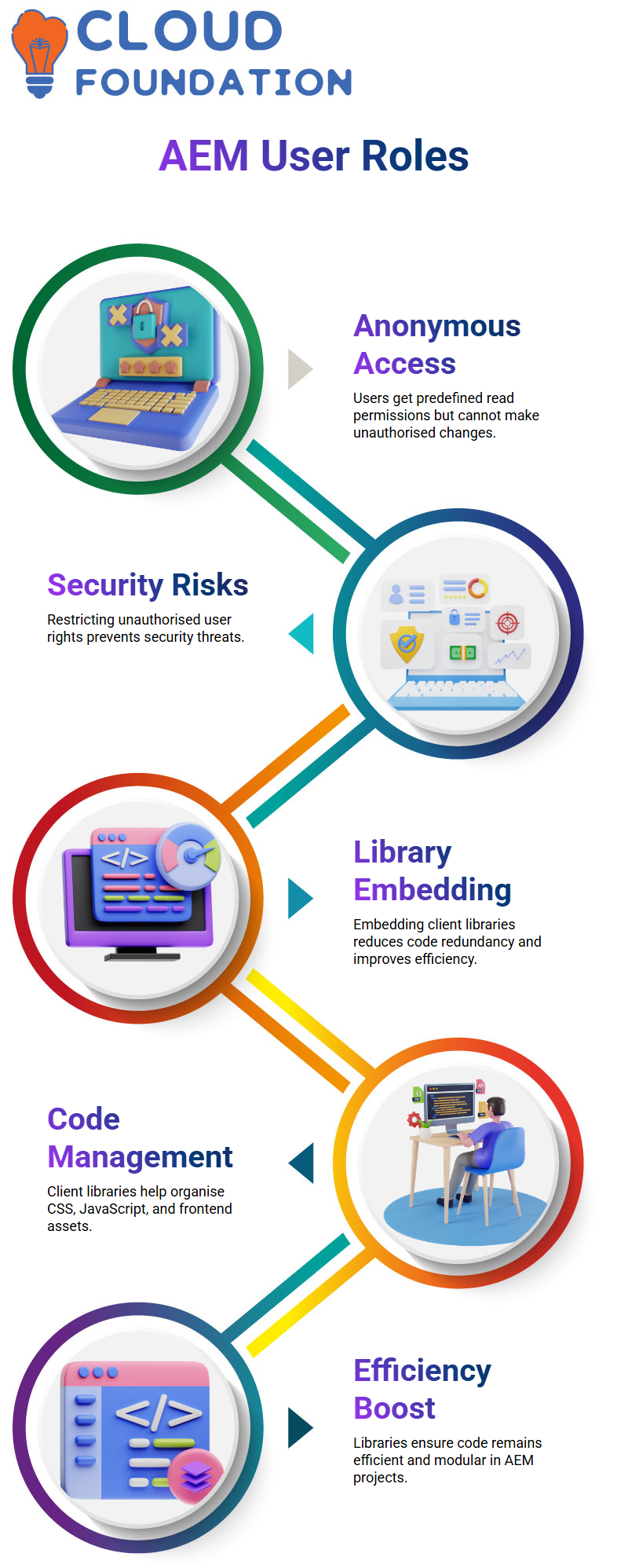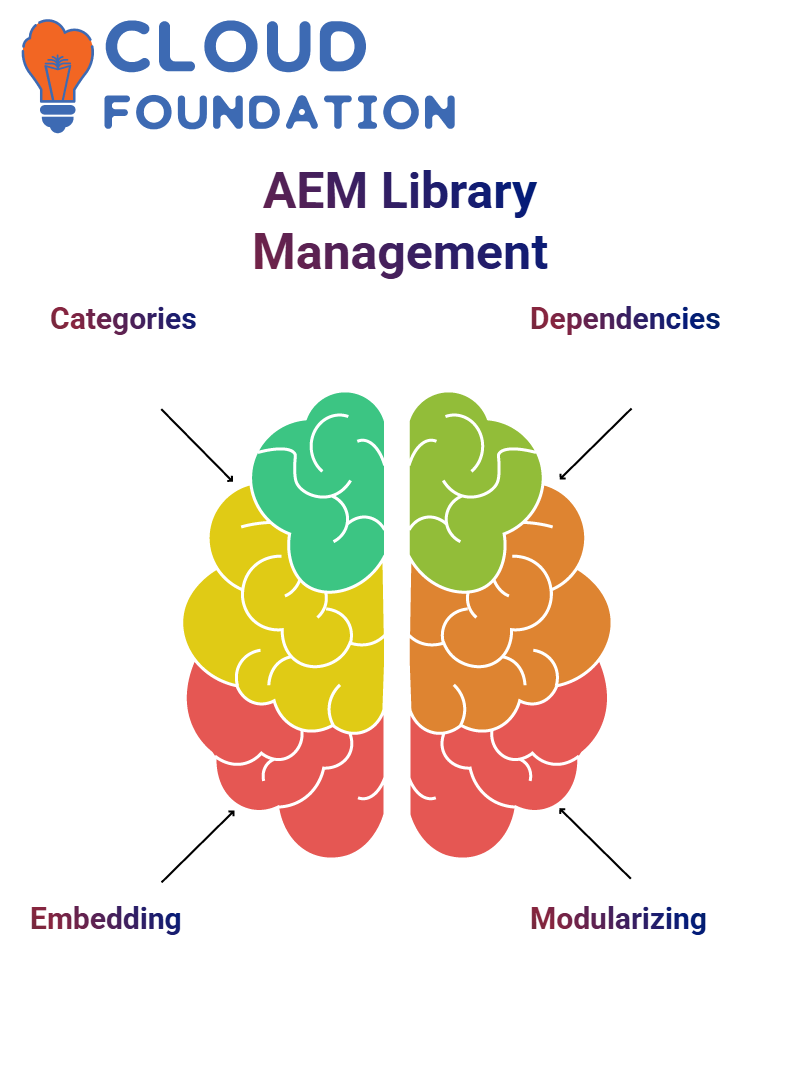AEM Client Libraries | AEM Configurations & Logs
Understanding AEM and Client Libraries
Adobe Experience Manager (AEM) is an efficient way for developers to manage digital assets. One key part of its operation involves client libraries.
They store customised code like JS or CSS, which ensures content delivery without interruptions or glitches.
As you work within AEM, it may become apparent that specific files, such as CSS and JS, are loading from unexpected paths.
A result of AEM internally selecting their loading paths and not from you, as intended. Here lies an intriguing mystery: why has AEM chosen such specific paths from which to load them?
AEM’s Apps Hierarchy and User Permissions
AEM provides an application hierarchy as a repository for custom code; however, users accessing published instances do not have permission to read from it, which is part of an effective security mechanism to prevent unapproved code modifications.
End users have limited access to content folders, which ensures they can view content without interfering with core functionalities.
AEM’s Proxy Mechanism for Client Libraries
AEM employs a proxy mechanism for loading client libraries. Since end users cannot directly access apps, AEM redirects these libraries through etc.clientlibs.
Ensuring the timely and correct delivery of essential JS and CSS components.
By setting the allow Proxy property, AEM will enable resources to load without jeopardising security.
Anonymous Users in AEM
When visitors arrive on websites, Users in AEM will be created with an anonymous user role that has predetermined read permissions and is restricted from making modifications or making any unauthorised changes.
Unauthorised users could pose security threats if granted full access in AEM; thus, limiting their rights is key to maintaining a safe environment.
Embedding Client Libraries in AEM
AEM allows developers to embed client libraries to reduce redundancy in code. Instead of duplicating JS files, developers can utilize AEM’s embed property and reference existing client libraries instead.

For example, if a search component requires code from another library, rather than recreating the same JS by hand, embedding this library increases efficiency while keeping AEM projects tidy.
Understanding AEM Client Libraries
Are you ready for some Adobe Experience Manager/AEM fun and learning about client libraries? Client libraries are essential for managing and organising AEM’s CSS, JavaScript and frontend assets.
Are You Working in AEM? For anyone familiar with AEM, libraries are essential for keeping code efficient and modular.
The Role of Categories in AEM
A category is invaluable when working in AEM; it acts as an identifier of client libraries so your library doesn’t work without one!
Think of naming your library like people addressing you by your name: whether that be family members, close acquaintances or simply oneself! In AEM these names help identify and load specific client libraries when required.
Embed vs. Dependencies in AEM
Let us now examine the difference between embedding code from another library as part of your main client library, including it directly as a dependency, and loading all that code through one network call. The latter provides more flexibility.

Dependencies enable client libraries to depend on another library while remaining standalone – this keeps things modular and efficient while making network calls for both libraries at once.
So this keeps AEM user libraries modularized efficiently. Incorporating Dependencies into Client Libraries
Modularising Your Client Libraries in AEM
AEM allows you to organize files efficiently by creating folders within your client library for JavaScript, CSS and so forth.
For instance, creating a ‘js’ folder would allow you to place all JavaScript files inside. When configuring the AEM Client Library Configuration, define its base path name.
The Importance of Proper Configuration in AEM
Make sure your client library in AEM is configured appropriately! Proper configuration ensures smooth code execution by specifying categories, dependencies, and embedding other libraries. Failing to do this correctly could create issues later. Don’t rush this task; take your time.
Understanding AEM Backend Configurations
Today, I would like to provide some insight into some AEM backend configurations that have helped us manage APIS and credentials more effectively.
” This solution can be game-changing, and I can’t wait to explain it further.
Imagine you need to connect to an API from a third-party vendor that comes equipped with different URL, user, and password configurations across development, staging, and production environments.
This “connecting-by-url-name-password-switcher” allows for seamless transition.
Where should login, username, and password credentials be stored securely? AEM offers an innovative alternative: WCA Configuration.
With it you can safely store configurable values like URLS, usernames and passwords.
Why Choose WCA Configuration in AEM?
WCA Configuration’s greatest strength lies in its flexibility—even if your credentials are entered incorrectly, no server restart is required!
Change the username or password in WCA Configuration and it will immediately take effect in your code. For instance, say your AEM application uses credentials from third-party APIs for connection; and its password has become incorrect.
In such a situation, simply update its credentials in WCA Configuration to access them immediately from code.
Simply access WCA Configuration, update password values, and the system dynamically picks them up without needing a reboot.
Creating WCA Configuration in AEM
Constructing WCA configuration in AEM is straightforward. I began by creating an example configuration using @ObjectClassDefinition annotation which designates classes as WCA Configurationss.
Named the Sample Configuration to easily distinguish it, I use @AttributeDefinition to define its attributes such as URL, username and password.
These attributes become configurable values you can dynamically change during runtime! Isn’t that amazing?
Integration of WCA Configuration in AEM Services
To fully leverage WCA configuration values within AEM Services, they should be referenced using @designate annotation to bind their configuration class with them and make use of configuration values in your code effortlessly.

My init method allowed me to quickly retrieve the configuration, while another built a string using values stored within.
It was amazing seeing AEM seamlessly integrate dynamic configurations into its workflow!
Accessing Configurations in AEM Console
After you deploy the code, your configuration becomes available within Adobe’s AEM Configuration Manager Console.
From here you’ll see both your customized Sample Configuration as well as other out-of-the-box configurations provided by them.
Adobe has stored their default API settings here as well, making this console an efficient way of managing and tweaking custom and built-in configurations alike.
Understanding AEM Resource Hierarchy
AEM’s resource hierarchy was designed for efficiency and flexibility; when you move files between folders such as “libs” and “apps,” priority goes to the latter one.
AEM provides a built-in configuration known as Resource Search Path that determines how paths should be searched sequentially.
Consider it this way: the execution process checks ‘apps’ before moving onto ‘libs.’ By organizing resources this way, AEM ensures that customisations take priority over traditional code changes.
With its clever system for resource organization and prioritizing customisations first and libs second, developers have access to an impressive way of expanding functionality without changing or altering core code directly.
Simplifying Configurations in AEM
Let’s review AEM’s out-of-the-box configurations; OSGi configurations offer revolutionary flexibility that enables you to make adjustments without making code modifications.

Resource Search Path configurations allow for managing priority in resource paths, while you can manage them via OSGi Console. One advantage to this approach is its versatility.
Once your changes are saved, AEM immediately recognizes them – be they URL, username or password values.
Making AEM Configurations Future-Ready
Enhancing AEM Configurations Future-Ready Hard coding values such as API endpoints, usernames and passwords is no longer viable in AEM.
OSGi configurations offer an elegant solution by making these items configurable so they can easily adapt to changes as they arise.
As an example, when updating an API endpoint from Yahoo to Google, simply make the change within OSGi Console, and it will immediately reflect in AEM without the need for server restarts or deployment delays – seamless updates!
AEM Run Modes and Configurations
Run modes in AEM provide you with an outstanding way of configuring settings for different environments, whether that means an author/publish configuration or something more unique like production/dev. With AEM you can manage these settings efficiently!
By organizing your configuration folders using names such as ‘config.author.prod,’ AEM automatically applies relevant settings during runtime to ensure a uniform and manageable environment for you and your teams.
Overcoming Challenges in AEM Configuration Management
An essential challenge of AEM configuration management is ensuring that settings persist between deployments; manual changes made via OSGi Console may become obsolete during subsequent releases, rendering any previous settings obsolete and subject to overwriting by AEM during further deployments.
To solve this, include configuration settings within your codebase. AEM provides the ‘ui.config’ module as a solution that makes configurations deployable and maintainable across environments.
By using it, your configurations become deployable and maintainable with each environment change.
Effortless Updates with AEM Configurations
AEM makes configuration changes effortless: you can update API credentials without restarting your server, and the changes take effect instantly!
Agility in development and deployment cycles is invaluable, while AEM allows for seamless OSGi configuration management that makes managing dynamic values like URLs, usernames and passwords simple and manageable without hindering workflows.
By effectively using OSGi configurations, facilitate its management system robust yet adapts easily to suit varying workflow needs without disrupting workflow.
Understanding AEM Configuration
Let’s dive deeper into AEM and its configuration. Successful AEM work relies heavily on proper configuration management.
I have encountered instances in which different folders contain many configurations, making it hard to know which should take priority.
AEM uses run modes to determine which configuration should be applied. For instance, you might have two folders named ‘config.author.prod’ and another with just “config.”
Both folders may match specific run mode conditions more effectively; AEM will always prioritize one over the other.

Creating a Configuration in AEM
An XML file is needed as the foundation for setting up configurations in AEM. I always ensure the name matches what service relates to each configuration file instead of giving them random titles.
How AEM Chooses the Best Configuration
One key aspect of AEM configuration involves understanding which folder wins when multiple configurations exist.
AEM will select the configuration that corresponds more precisely with any service triggered in an author instance when there are multiple matching configurations–in this instance ‘config.author.prod’–to trigger.
As AEM defaults to its most generic configuration if no specific match can be made, I always ensure my configurations align appropriately with AEM’s priorities.
Deploying Configurations in AEM
Once configurations have been determined in AEM, proper deployment is key in terms of keeping them accurate.
Any manual modifications made will revert when deployed without commiting them back into the codebase.
Learned the hard way! AEM keeps everything streamlined, so if I change values in my configurations, I always ensure they’re added adequately before deployment – otherwise they disappear!
Making Configurations Run-Mode Specific in AEM
AEM provides configurations with run-mode-specific settings. That means if I require different values depending on my environment (author versus publish, for example) I can structure my folders accordingly.
For example, one could be created called ‘config.author.prod’ with production values while keeping another called’ config. author’ to store default values or defaults, respectively.

As AEM selects values automatically from run mode names, I double-check that it uses them correctly.
A simple typo could cause AEM to pick the incorrect configuration, causing serious problems for our engine.
Avoiding Common Mistakes in AEM Configuration
A familiar misstep developers make in AEM is misnaming configuration files; rather than reflecting just its content as is, their names should reflect which service or feature the file pertains to.
Another recurring challenge is failing to commit configurations properly before deployment, which leads to unnecessary confusion and debugging during implementation.
Without version control, manual changes might vanish upon deployment, creating further frustration during troubleshooting sessions.
Understanding AEM Log Files
Logs in AEM play an indispensable role when working with AEM, and it is imperative that users are well-versed in how the different logs operate in order to troubleshoot issues or just keep an eye on their system’s health and performance.
With AEM’s Log Folder available online, navigating logs in AEM is simple—using it is even possible!
Navigating the AEM Log Folder
AEM methodically stores all repository-related tasks and information in its log folder; here, you record every operation performed within AEM and each code execution or system message sent out from AEM.
Exploring AEM’s log folder reveals numerous logs.
These logs capture vital data about how the application behaves, helping developers and administrators keep an eye out for any significant events that arise within it.
The Importance of Error.log in AEM
error.log is one of AEM’s essential log files, providing valuable insights into application errors and system-wide issues.
Each time someone refreshes a page, triggers a function, or runs custom code, the action leaves a mark in error.log.
When an issue occurs in AEM, Error.log should always be your starting point. It contains records of execution failures, application errors, and debug information.
Such as Java-related errors or service outages, so error.log can help quickly pinpoint the root cause.
How Error.log Supports Debugging in AEM
Error.log Provides Support for debugging in AEM Debugging AEM becomes straightforward when error.log is utilised effectively.
Any failed service execution, broken functionality or missing dependencies that leave their trace will leave behind signs in error.log developers regularly utilise to identify problems and correct misconfigurations.
AEM ensures error.log captures both application- and system-wide issues. Should any suspected problems arise, searching error.log for actionable insights could provide efficient solutions to address them quickly.

Exploring Other Log Files in AEM
AEM maintains various logs besides error.log to collect specific types of information. Each serves a distinct function, so administrators and developers can track events systematically.
Logs generated by AEM help identify errors and improve performance. By tracking logs regularly, you can detect anomalies within configuration files or systemic problems before they arise, helping ensure system stability for any developer or administrator.
Therefore, keeping tabs on AEM logs should always be an essential task of their job duties.

Sai Susmitha
Author



